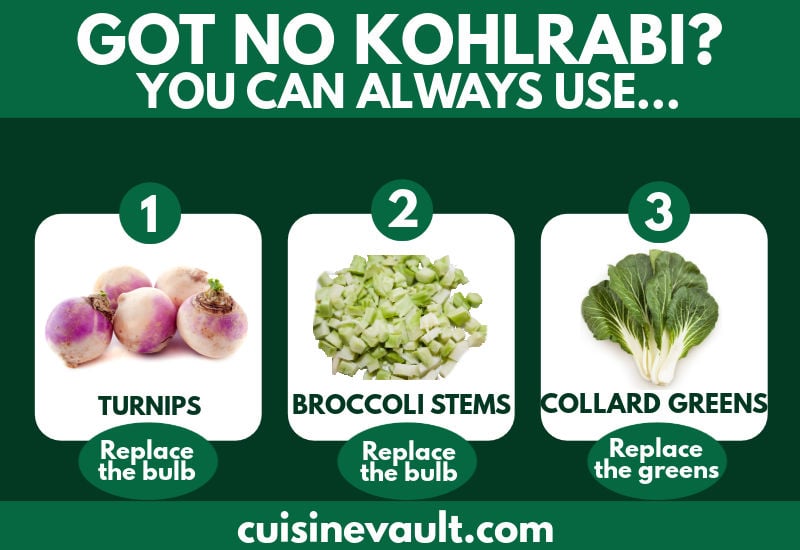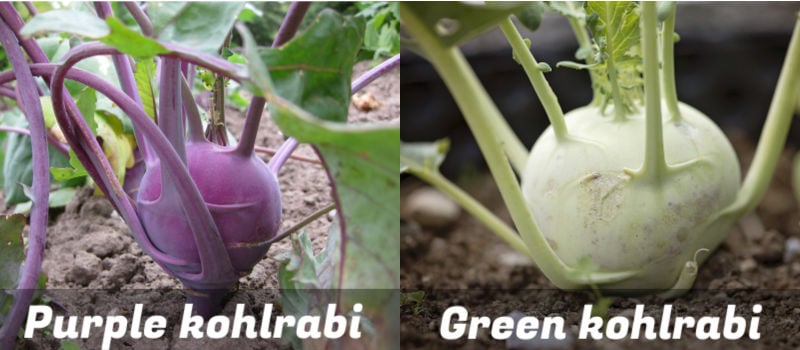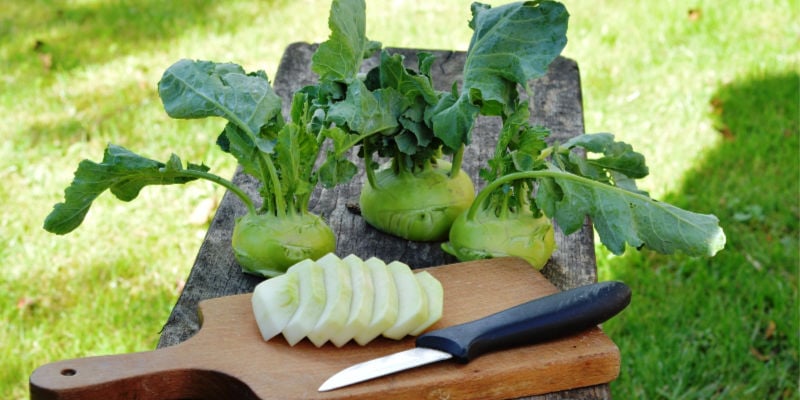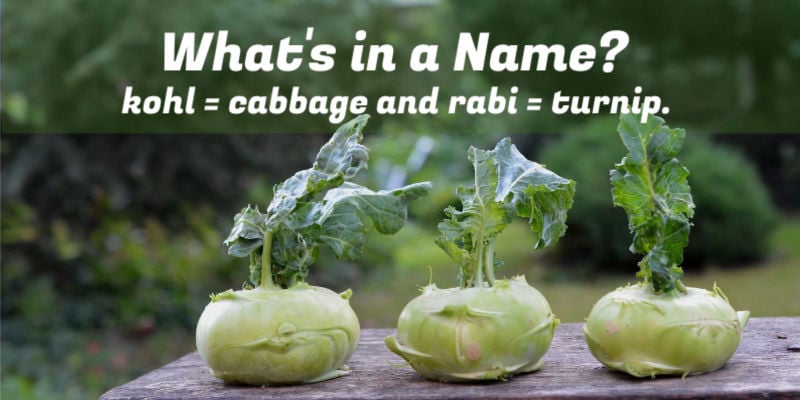The kohlrabi, or German Turnip, is an unusual-looking vegetable that loves cold weather. Although it shares some characteristics with its cousins the broccoli, cabbage, and kale, the kohlrabi has a unique look and taste.
Even if you have a well-stocked grocery store that sells kohlrabi, they may not always be available or in-season. If you’re in the middle of a recipe that calls for this vegetable, you’ll need a suitable kohlrabi substitute. Keep reading to get the best replacement options for your next dish.
What are the best kohlrabi substitutes?
To replace the kohlrabi bulb use turnips, broccoli stems, celeriac, or radishes as your best options. Collards, green chards, Malabar spinach, or kale can be used to replace kohlrabi leaves in cooking.
 1. Turnips
1. Turnips
Use to replace the bulb
Turnips have a similar taste to kohlrabi, although they are sharper and their texture isn’t as soft. They’re perfect for use in slow-cooked recipes or as a mash.
2. Broccoli stems
Use to replace the bulb
Broccoli stems share a similar texture to the kohlrabi bulb, but they’re less peppery and sweet. They work well roasted, sauteed, or steamed.
3. Celeriac
Use to replace the bulb
Celeriac tastes a bit like celery, but will also work as a useful kohlrabi bulb alternative. It is perfect as a mash or used to make a remoulade.
4. Radish
Use to replacing the mature bulb
As the kohlrabi matures, it loses its sweetness and develops a sharper flavor that is similar to a radish.
5. Collards
Use to replace the greens
Although raw collard greens are more bitter than kohlrabi greens, their flavor softens once cooked. They’re excellent added to stir-fries or sauteed.
6. Swiss chards
Use to replace the greens
Green chards can be eaten raw or cooked, but some find their flavor too bitter without cooking.
7. Malabar spinach
Use to replace the greens
Malabar spinach is excellent for replacing kohlrabi in raw applications like salads.
8. Kale
Use to replace the greens
Kale has a strong, earthy taste and crunchy texture that is suitable for eating raw or cooked. If you prefer milder tasting greens then select younger kale plants that have softer leaves without the intense flavor.
Get fast facts in this 1 minute video
Purple vs. Green Kohlrabi
Are you trying to decide whether green or purple kohlrabi is the best option? Although their appearance is different, the flavor is the same. You’re best to make a choice based on which color you prefer rather than taste.

Taste Profile
Kohlrabi is a crisp, juicy vegetable with a mild and slightly sweet flavor, not unlike broccoli stems. There are also some flavor similarities to radish and cabbage.
The kohlrabi leaves are similar to collard greens in flavor. Look for the small leaves that are picked in early spring as these are more tender and juicier.
When selecting kohlrabi, look for the smallest bulbs on offer. These are milder and sweeter than the bigger, more fibrous ones. You can choose large kohlrabi for stuffing.
Quick Tip: The outer layer of the kohlrabi is fibrous and not pleasant to eat, so peel this off. Keep in mind that this layer is quite thick so the amount of edible flesh is less than you may think. When you find kohlrabi at the store, buy a little more than you think is needed so that you don’t run out.
How to prepare kohlrabi
- If the stems and leaves are still intact, cut them off. These can be used in salads and sandwiches if they’re not too old and tough. Otherwise, saute or braise them.
- Take the kohlrabi bulb and slice off the bottom and discard it.
- Use a vegetable peeler or knife to remove the outer fibrous layer from the bulb.
- The bulb is now ready to be sliced, diced, grated, or cooked whole.

Culinary uses for kohlrabi
If you can grow kohlrabi or buy it from a Farmers’ market, you’ll be able to use the bulb and the leaves. Unfortunately, many supermarkets remove the stems before selling.
Best uses for the leaves
- Toss into salads for added color and flavor.
- Add to a stir fry with chicken and vegetables.
- Layer into lasagna for some extra texture.
- Saute and toss with olive oil and salt.
- Add to an omelet or frittata for added nutritional benefits.
- Include with artichoke to make a dip.
Best uses for the bulb
- Cut into thin sticks for a coleslaw.
- Add to any potato dish.
- Include in hearty vegetable soups.
- Blend into a puree with spices.
- Bake veggie chips for a healthy snack.
- Use for making remoulade.
- Stuff them with your favorite fillings.
Suggested reading: How to microwave artichokes if you're in a hurry.
Frequently Asked Questions
How many carbs are in kohlrabi?
There are 6g of carbohydrates per 100g of the vegetable.
Can you eat kohlrabi raw?
Kohlrabi is delicious eaten raw and offers a range of nutritional benefits. Grate the bulb using a mandolin to create a salad tossed with olive oil and celery salt. Alternatively, try the leaves in a garden salad or sandwich. The leaves become tough as they mature so select the fresh, new ones.
How do I store kohlrabi?
Place the uncooked kohlrabi bulb in a plastic or paper bag and store it in the vegetable crisper for up to 2 weeks. The leaves should be used within three days.
Freeze kohlrabi for 10-12 months. It’s best to cut the bulb into cubes and blanch for one minute before draining, cooling, packing in sealable plastic bags, and then freezing. If you don’t want to chop the kohlrabi, then leave it intact and blanch the bulb for 3 minutes before freezing.
Do you know where the name kohlrabi comes from? Kohl means cabbage, and rabi means turnip.

Kohl means cabbage, and rabi means turnip.
Final Words
Kohlrabi is a versatile ingredient that can be used in a wide range of recipes. However, it can be hard to find in some parts of the world. If you’re unable to find kohlrabi where you live, one option is to grow your own. Assuming you have the right climate, kohlrabi is a hardy plant that isn’t difficult to grow.
If you don’t have a green thumb, or the space to grow vegetables, you can look at using a kohlrabi substitute. Several options will work well in recipes. Turnips, broccoli stems, celeriac, or radishes are good for replacing the bulb. Collards, green chards, Malabar spinach, or kale make excellent replacements for the greens.
Another option is leaving the kohlrabi out of a recipe. If you’re using this vegetable as the hero ingredient, then this option won’t work. But it’s a good option if you’re dicing the kohlrabi for a casserole or stir-fry. It won’t be a deal-breaker for the meal by leaving it out of the dish.

Leave a Reply